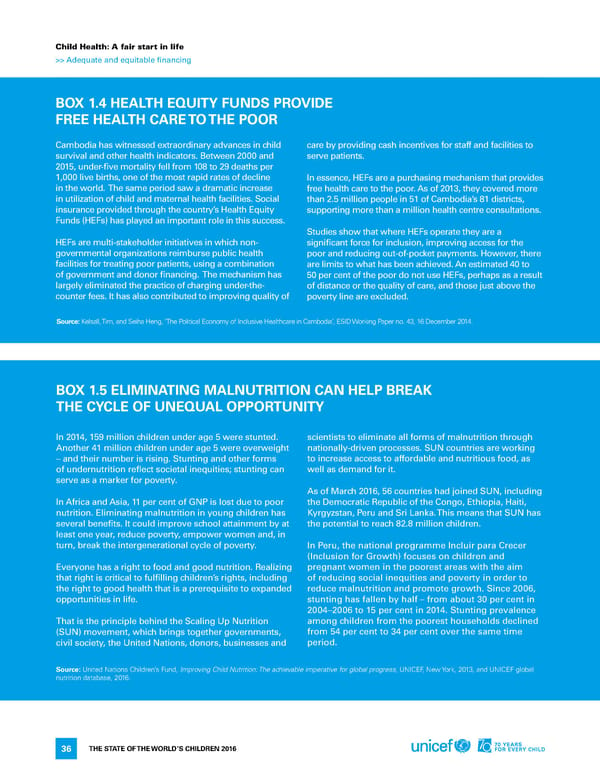Child Health: A fair start in life >> Adequate and equitable financing BOx 1.4 HEALTH EqUITY FUNDS PROvIDE FREE HEALTH CARE TO THE POOR Cambodia has witnessed extraordinary advances in child care by providing cash incentives for staff and facilities to survival and other health indicators. Between 2000 and serve patients. 2015, under-five mortality fell from 108 to 29 deaths per 1,000 live births, one of the most rapid rates of decline In essence, HEFs are a purchasing mechanism that provides in the world. The same period saw a dramatic increase free health care to the poor. As of 2013, they covered more in utilization of child and maternal health facilities. Social than 2.5 million people in 51 of Cambodia’s 81 districts, insurance provided through the country’s Health Equity supporting more than a million health centre consultations. Funds (HEFs) has played an important role in this success. Studies show that where HEFs operate they are a HEFs are multi-stakeholder initiatives in which non- significant force for inclusion, improving access for the governmental organizations reimburse public health poor and reducing out-of-pocket payments. However, there facilities for treating poor patients, using a combination are limits to what has been achieved. An estimated 40 to of government and donor financing. The mechanism has 50 per cent of the poor do not use HEFs, perhaps as a result largely eliminated the practice of charging under-the- of distance or the quality of care, and those just above the counter fees. It has also contributed to improving quality of poverty line are excluded. Source: Kelsall, Tim, and Seiha heng, ‘The Political economy of inclusive healthcare in Cambodia’, eSid Working Paper no. 43, 16 december 2014. BOx 1.5 ELIMINATING MALNUTRITION CAN HELP BREAk THE CYCLE OF UNEqUAL OPPORTUNITY In 2014, 159 million children under age 5 were stunted. scientists to eliminate all forms of malnutrition through Another 41 million children under age 5 were overweight nationally-driven processes. SUN countries are working – and their number is rising. Stunting and other forms to increase access to affordable and nutritious food, as of undernutrition reflect societal inequities; stunting can well as demand for it. serve as a marker for poverty. As of March 2016, 56 countries had joined SUN, including In Africa and Asia, 11 per cent of GNP is lost due to poor the Democratic Republic of the Congo, Ethiopia, Haiti, nutrition. Eliminating malnutrition in young children has Kyrgyzstan, Peru and Sri Lanka. This means that SUN has several benefits. It could improve school attainment by at the potential to reach 82.8 million children. least one year, reduce poverty, empower women and, in turn, break the intergenerational cycle of poverty. In Peru, the national programme Incluir para Crecer (Inclusion for Growth) focuses on children and Everyone has a right to food and good nutrition. Realizing pregnant women in the poorest areas with the aim that right is critical to fulfilling children’s rights, including of reducing social inequities and poverty in order to the right to good health that is a prerequisite to expanded reduce malnutrition and promote growth. Since 2006, opportunities in life. stunting has fallen by half – from about 30 per cent in 2004–2006 to 15 per cent in 2014. Stunting prevalence That is the principle behind the Scaling Up Nutrition among children from the poorest households declined (SUN) movement, which brings together governments, from 54 per cent to 34 per cent over the same time civil society, the United Nations, donors, businesses and period. Source: United nations Children’s fund, Improving Child Nutrition: The achievable imperative for global progress, UniCef, new York, 2013, and UniCef global nutrition database, 2016. The STaTe of The World’S Children 2016 36
 70 Years for Every Child Page 50 Page 52
70 Years for Every Child Page 50 Page 52